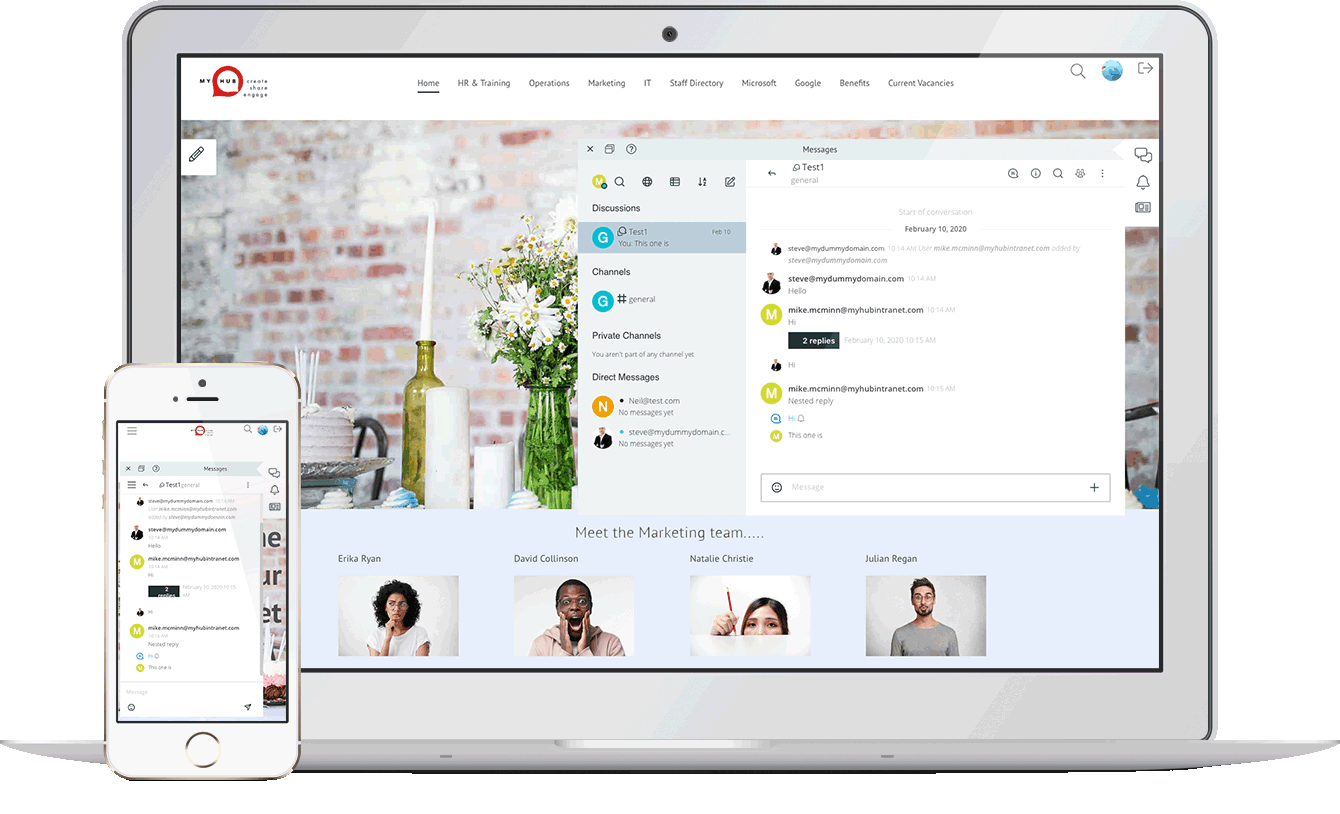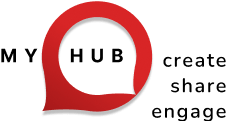Team Collaboration
How To Help Staff Connect, Encourage Ideas, And Move Work Forward
Share. Communicate. Innovate

Team collaboration is a prominent trait among today’s winning organizations. Done right, collaboration aids better decision-making, innovative thinking and improved productivity. Staff are happier, performance is boosted, and there’s less risk of error.
But many organizations have yet to figure out how to help colleagues work better together to achieve a common goal.
The good news is that there are tools and techniques that have proven to nurture a strong collaborative culture within the workplace.
Here, we shed light on the causes of poor collaboration, tips for improvement, and collaboration software that enables co-workers to share ideas and improve internal communications.
What Is Team Collaboration?

The definition of team collaboration is when two or more people work together to achieve a common goal. This is done through idea sharing, planning and executing in unison. In contrast to working on one’s own, team collaboration is regarded as a more productive way to get work done, and carries less risk.
Tackling a major project – such as a new product launch or the introduction of a new internal process – usually requires a teamwork approach. This entails bringing together a group of employees to allocate and complete tasks, within a set timeframe.
These days, with technology overcoming geographical barriers, virtual teams are popular. Companies are now appointing the best people for a project – regardless of their work location – to form part of a team and collaborate. This development has created new opportunities for businesses to innovate – but is not without its challenges.
Why Is Team Collaboration Critical In The 21st Century?

Never before has the workplace been so diverse. For the first time in history, five generations are working side-by-side. Each employee has a unique perspective. Their opinions are formed by their own personal experiences. And they have different communication styles – some prefer face-to-face, others the written word.
Such differences are a lot to manage, particularly when complex, project-based decisions must be made.
How a team interacts with each other will influence the final outcome. Communication, knowledge transfer and equal respect for each team member are essential for a high-performing team.
Younger generations joining the workforce are eager to further develop the collaborative skills they’ve learnt during education. They place place greater support on social tools for collaboration than their older colleagues (49 per cent millennials vs 31 per cent baby boomers). And considering that 46 per cent of 2020’s workforce are millennials (compared with 36 per cent six years ago), employers must act upon this growing generation’s preference for building team dynamics.
Furthermore, around 75% of employees now rate teamwork and collaboration as crucial to their performance.
Reasons For Poor Team Collaboration
It’s a common scenario when a collection of people come together to solve a problem, cross-functionally. There may be representatives in the room from IT, Sales, Product and Finance.
When collaboration fails, it’s often because these individuals partially listen to others points-of-view, but do not fully seek to understand what they were actually saying.
Each representative remains in their own paradigm rather than genuinely taking on board and seeking a solution based on other perspectives.
To counter this, effective collaboration requires recognition of diversity; that each individual has their own thought process and purpose. This requires greater understanding of the team individuals, and the concerns they may be feeling.
These could include the following:
- Skepticism about the success of the project i.e.‘doomed to fail’
- Uncertainty around who does what in the team, and where tasks and responsibilities sit
- Misinterpretation or miscommunication: wrongly assuming all staff have the same understanding
- Lack of direction, KPIs and milestones set out from the start
- Conflicting priorities: failing to appreciate an employee’s current workload before adding more
- Forcing staff to communicate in ways that may be uncomfortable for them i.e. introverted employees making team presentations
How To Improve Team Collaboration
Successful team collaboration is hard work. With so much to consider – silos, company culture, staff at different locations, leadership styles – good team collaboration doesn’t happen by accident.
Furthermore, Harvard Business Review has exposed an interesting paradox at play, based on its research into team behavior:
“Although teams that are large, virtual, diverse, and composed of highly educated specialists are increasingly crucial with challenging projects, those same four characteristics make it hard for teams to get anything done.
“To put it another way, the qualities required for success are the same qualities that undermine success. Members of complex teams are less likely to share knowledge freely, to learn from one another, to shift workloads flexibly to break up unexpected bottlenecks, to help one another complete jobs and meet deadlines, and to share resources.”
It also found that the higher the educational level of the team member, the more challenging collaboration appears for them.
But there are some best practices for building effective collaboration strategies, as follows:
Define And Repeatedly Communicate The Team’s Goals
This is the first step to bringing together a group of people. Goals should be reiterated at the start of daily huddles, referred to when key decisions are underway, and repeated across all communication channels (your intranet, for example).
Promote Open Communication Particularly When Faced With A Roadblock
This is where technology has become a game-changer. Instead of waiting for the next round-table meeting to overcome a roadblock, intranet tools such as forums, instant messaging, and shared files allow members of the same team to work through a problem collaboratively at pace.
Create Structure Within Meetings And Give Staff Time To Prepare
WIP (work-in-progress) meetings are an important part of effective project management. Ahead of each meeting, share agenda items, action lists and related reading material with all members of the team so there are no frustrating delays when teams meet.
Encourage Creativity And Free-thinking: All Ideas To Be Respected
Brainstorming sessions can be fun and fruitful. Team leaders must give advance warning though so staff can do their own research. And if you’re the manager, resist the urge to direct and jump in immediately with your ideas, as staff may feel obliged to follow.
Log Important Decisions And Their Backstory
Avoid the “he said/she said” nature of spontaneous conversations; make sure ideas are contextually documented in a central space, accessible for all, and not lost in the moment.
Invest in Collaboration Tools
Team collaboration tools have shown the way here. Employees can set up team channels where decisions can be made in real-time. Slack, the popular chat tool, has been joined by a host of other instant messaging tools, virtually eliminating the need for traditional email. Video conferencing, in the wake of Covid-19, has become the default meeting format. And forums are another effective channel for effective team collaboration.
Check For Understanding
Nodding heads does not necessarily mean agreement and understanding. Many co-workers won’t like to admit they don’t understand something. Reiterate major decisions – during and after meetings – providing clarity and an opportunity for others to ask further questions. Engage in two-way communication with all members when possible.
Create Ways For Less Outspoken Team Members To Contribute Ideas
Not everyone has public speaking skills. Shy people will not feel comfortable sharing their idea in a room full of colleagues, but may happily submit an idea via a forum or chat channel. Make it known that individual thinking is unique and valued, and that every team member should be able to communicate with equality and authority.
Share Experience, Knowledge And Resources
Use an intranet to capture treasured insights – physically and virtually with file-sharing software. This will save mistakes being repeated, and knowledge walking out the door when someone leaves. Don’t leave this to chance: embed a process for eliciting and storing this valuable intelligence as part of your regular WIP meetings. Add tags to meeting notes that can be searched for later on.
Acknowledge And Celebrate Individual And Team Success
Highlight individual qualities and the special skills that each team member brings to the table. Go big when a milestone or key task has been ticked off with a team building celebration event. This boosts morale and makes people feel valued.
Appoint Task And Relationship-Oriented Leaders
HBR research found that the most productive and innovative teams had leaders who could outline clear goals and responsibilities and easily switch to relationship-building mode i.e. smoothing out internal tensions.
Limit Group Sizes
Not always possible – particularly if you’re about to organize the next Olympics – but aim to keep teams small enough so that staff get to know (and respect) each other, and ideas exchange freely. Big teams tend to be more vulnerable to tunnel vision, or the ‘squeakiest wheel wins’.
❝
Collaborative teams are 5 x higher performing as they feel motivated towards a common goal
Source: i4cp
Team Collaboration Trends
Team Collaboration tools are evolving to suit the changing needs of businesses today.
Flexibility, scalability, and compatibility with existing systems increasingly matter. Because of this, enterprise players such as Cisco, Slack and Microsoft have no choice but to integrate with each other.
Some other noticeable trends in team collaboration include:
Artificial Intelligence
Machine learning tools and bots can help an entire team improve the way they collaborate by making it easier to find information instantly. They can also offer things like real-time translation and transcribing during video conferencing meetings.
Unique Experiences
As more technology vendors come to the integration and interoperability party, open-source platforms with the help of APIs are enabling employers to build their own collaboration experience, just right for their internal culture.
Love Of Video
This format’s popularity continues to rise, but so do expectations around its performance. With remote teams the new normal, businesses are relying more on video conferencing, which must be reliable, secure and consistent.
Team Collaboration Software
Creating a workplace using team collaboration software is a practical move that can really transform how you and your colleagues collaborate.
MyHub’s cloud-based intranet is designed specifically for organizations in search of an affordable and adaptable collaboration solution. It’s fully scalable, designed to support your company’s growth. And fully customizable, to meet your exact needs.
Combining a company internal newsfeed, instant messaging and secure cloud storage, MyHub is the perfect choice for your important projects-in-progress.

Whether you’re an IT pro or completely non-technical, MyHub’s cloud-hosted solution offers all the features and functionality you’ll ever need.
We’ve made it so that it’s super simple to set-up (no coding skills or IT experience required) – and is enjoyable to use!
Using simple drag-and-drop functionality, you can create a professional space for your team to start collaborating in minutes! Being cloud-hosted also means you’re future-proofing your investment: you get to benefit from our latest new features and enhancements as soon as they’re released.
Useful Team Collaboration Resources
Essential Strategies for a Successful Banking Intranet
Banks and financial institutions have unique needs—strict regulatory oversight, high expectations for data security, and the demand for highly efficient internal operations. A finance or banking intranet offers a private, secure network designed to address exactly those challenges. It centralizes communication, improves collaboration across departments, and creates one source of truth for policies, documents, forms, workflows and internal news.
The benefits are wide-ranging. With a well-implemented intranet, financial teams can boost productivity by reducing time spent searching for documents, ensure compliance by controlling access and maintaining versioned policy documents, improve internal communication through company news feeds and recognition programs, and support knowledge sharing using searchable directories and blogs.
When planning a banking or finance intranet, several essential features and strategies stand out. Advanced security (SSL, multi-factor authentication, role-based permissions) is non-negotiable. Digital forms, customizable workflows, document management with version control, mobile-friendly access and real-time search functionality are also key parts of a successful platform. Finally, getting buy-in from employees, clear objectives, a carefully chosen platform, proper training, and alignment with compliance requirements are critical steps in the rollout process.
25 Intranet Content Ideas and Best Practices to Improve Your Intranet
Your intranet may have launched with excitement, but over time content can feel stale and starts to lose its pull. The post notes many organizations struggle with dwindling engagement, where employees say the intranet “doesn’t engage” like it used to. That signals a need for fresh ideas.
To revitalize your intranet, the article offers 25 content ideas designed to inject energy, relevance, and interaction. These span traditional updates like “Internal Communication” and “CEO News Blog,” visual content like video and graphics, people-focused posts including employee recognition or profile spotlights, remote team connections, gamification, onboarding hubs, health & wellbeing, and more. Each idea is meant to add value—make users feel seen, informed, and involved.
Finally, it wraps up with best practices to make content actually work: keep it relevant (don’t overload employees with noise), design it to be engaging (use visuals, interaction, employee-generated content), vary formats (mix text, video, polls, etc.), and plan ahead with a content calendar so there’s always something new. Also, ensure navigation & tagging make content easy to find, and routinely remove outdated or irrelevant material.
Finance Intranet: Benefits, Features, And User Examples
The financial industry faces unique challenges, including stringent regulatory requirements, data security concerns, and the need for efficient internal communication. A finance intranet serves as a secure, centralized platform that addresses these challenges by facilitating seamless collaboration, document management, and compliance tracking.
Key benefits of implementing a finance intranet include centralized information and document management, improved knowledge sharing, streamlined cross-departmental collaboration, enhanced internal communication, increased productivity, and better customer service. These advantages contribute to a more efficient and compliant financial institution.
Real-world examples demonstrate the effectiveness of finance intranets in various organizations. For instance, financial institutions have utilized intranet platforms to automate workflows, securely share documents, and facilitate communication across departments, leading to improved operational efficiency and customer satisfaction.
Disengaged Employees: How Deal With Disengaged Workers
Employee disengagement poses significant challenges to organizations, impacting productivity, morale, and overall performance. Disengaged employees often exhibit signs such as lack of enthusiasm, low energy, frequent tardiness, minimal effort, and avoidance of social interactions. These behaviors not only hinder individual performance but can also influence team dynamics negatively. Recognizing these signs early is crucial for timely intervention.
The causes of disengagement are multifaceted, ranging from poor alignment with the organization’s mission to lack of recognition and limited growth opportunities. Addressing these issues requires a comprehensive approach, including open communication, leadership development, and fostering a culture of appreciation. Implementing strategies that promote employee well-being and professional growth can significantly reduce disengagement levels.
Taking proactive measures to re-engage employees is essential. Strategies such as providing clear career development paths, offering regular feedback, and creating an inclusive work environment can reignite motivation and commitment. By investing in these areas, organizations can transform disengaged employees into active contributors, leading to improved performance and a more positive workplace culture.
Healthcare Intranet: Streamline Processes & Enhance Patient Care
Healthcare organizations face unique challenges when delivering patient care, often needing real-time access to protocols, workflows, and updates. A modern intranet serves as a centralized hub—offering a secure way to share policies, SOPs, workflows, and broadcast vital alerts to staff across facilities and mobile settings. Key features like two-factor authentication, privacy controls, and SSL encryption safeguard sensitive information in line with HIPAA requirements.
Beyond compliance, intranets simplify the daily lives of medical teams. Built to be user-friendly, visually engaging, and straightforward, these platforms sit on a strong foundation of no-code ease and custom integrations—whether for Microsoft 365, Google Workspace, or payroll systems. Designed for the fast-paced healthcare environment, they bring information directly to hands on the go via mobile apps.
Real-world use cases show how diverse healthcare settings benefit. For instance, aged care homes use intranets for social calendars, maintenance and care requests, digital SOP libraries, and family-facing extranet portals; Medical groups enable push-based workflow automations, blogs, video knowledge sharing, searchable contact directories, and shared on-call schedules; and multi-disciplinary clinics collaborate on practice docs via embedded tools, communicate instantly between sites, and publish recognition updates to keep morale high.
10 Must-Have Internal Communication Tools
Effective internal communication hinges on having the right mix of tools that foster clarity, connection, and engagement across diverse teams. The MyHub article presents the 10 most essential tools organizations should have in their communication toolkit—from central intranet platforms to mobile access and instant messaging. Each plays a role in bridging gaps and streamlining workflows today.
At the top of the list is the company intranet, a secure, central hub that links employees to information, resources, newsfeeds, directories, and collaborative tools. Complementary tools like mobile intranet apps ensure no one is disconnected—especially frontline or remote staff. Features such as update feeds, instant messaging, collaboration spaces, internal blogs/CEO messaging, knowledge management modules, feedback surveys, project tracking, and internal social networks round out a powerful agenda for engagement and productivity.
Together, these tools create a connected workplace where information flows seamlessly, feedback is honored, collaboration thrives, and every team member—regardless of location—has a voice. From actionable newsfeeds to two-way forums and social channels, modern internal communication goes deeper than broadcasting. It’s about building relationships, trust, and efficiency—all through purposeful tools.






